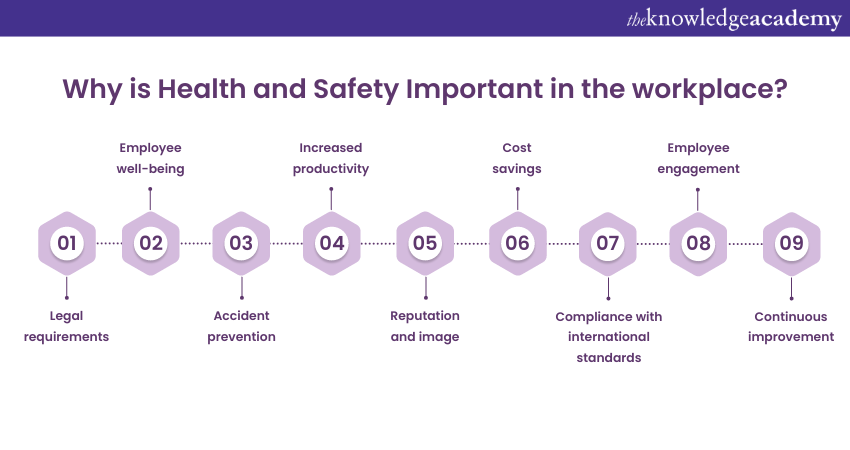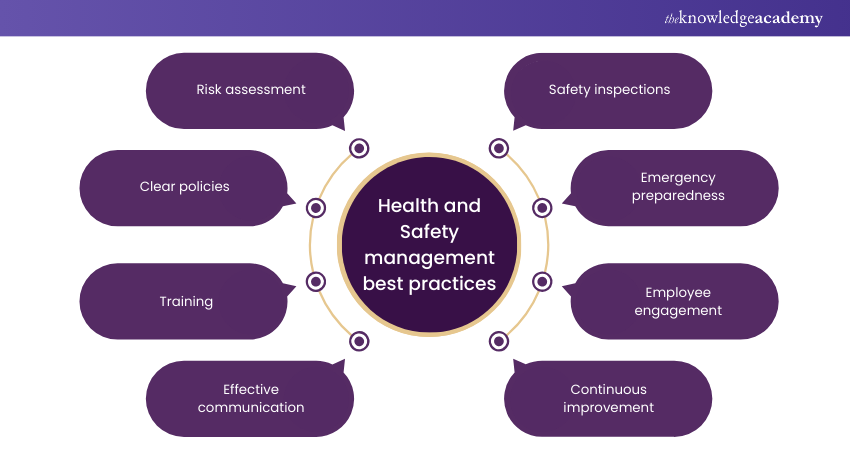We may not have the course you’re looking for. If you enquire or give us a call on 01344203999 and speak to our training experts, we may still be able to help with your training requirements.
Training Outcomes Within Your Budget!
We ensure quality, budget-alignment, and timely delivery by our expert instructors.

Health and Safety are key features in any work environment. Whether it be an office, a construction site, or a manufacturing plant, taking care of employees' well-being is paramount. But most organisations don't see that; they continue asking themselves, "Why is Health and Safety Important?” Read this blog to learn about the importance of Health and Safety in the Workplace, what benefits it brings, and why it is a priority of organisations. Delve in to learn more!
Table of Contents
1) Why is Health and Safety Important in the workplace?
a) Legal requirements
b) Employee well-being
c) Accident prevention
d) Increased productivity
e) Reputation and image
f) Cost savings
g) Compliance with international standards
h) Employee engagement
i) Continuous improvement
2) Best practices for effective health and safety management
3) Conclusion
Why is Health and Safety Important in the workplace?
Health and Safety in the workplace primarily refer to the collective efforts and measures taken to prevent work-related accidents, injuries, and illnesses. Health and Safety practices are essential to safeguard the well-being of employees. It helps maintain a positive organisational image, complies with legal requirements, and improves overall productivity. Now, let’s take a closer look at all the reasons why Health and Safety are important in the workplace:

Legal requirements
Maintaining adherence to Health and Safety regulations is a legal obligation for employers in the United Kingdom. The key legal requirements include the following:
1) Health and Safety at Work Act: This act outlines employers' duty to safeguard the health, safety, and well-being of employees and others who are affected by their work.
2) Risk assessments and control measures: Employers conduct risk assessments to identify threats and implement measures to control risks.
3) Training and information: Employers provide adequate Health and Safety training and ensure employees have the necessary information to work safely.
4) Reporting and record-keeping: Employers keep records of risk assessments, training, accidents, and incidents.
5) Workplace policies and procedures: Employers develop policies and procedures that reflect legal requirements and set guidelines for a safe work environment.
6) Regulatory inspections and enforcement: Health and Safety authorities conduct inspections to ensure compliance and enforce penalties for non-compliance.

Employee well-being
Employee well-being is vital for creating a positive work environment. Here's why it matters:
1) Physical health: Employers reduce injuries, illnesses, and absenteeism by ensuring a safe workplace and promoting healthy practices.
2) Mental health: Supporting mental well-being decreases stress, boosts job satisfaction, and enhances overall performance.
3) Job satisfaction: When employees feel valued, supported, and safe, they are more satisfied and motivated in their roles.
4) Work-life balance: Encouraging a healthy work-life balance reduces stress, prevents burnout, and improves overall well-being.
5) Team morale and collaboration: A positive work environment fosters positive relationships, effective communication, and stronger teamwork.
6) Employee engagement: Prioritising well-being leads to engaged employees who are committed and motivated in their work.
Accident prevention
Accident prevention is crucial for employee safety and overall well-being. Here's why it matters:
1) Protecting employees: Employers ensure the well-being of their workforce by identifying hazards and implementing safety measures.
2) Maintaining productivity: Preventing accidents helps to maintain a smooth workflow and avoid disruptions that can hinder productivity.
3) Reducing costs: Accident prevention minimises financial burdens associated with medical expenses, compensation claims, and legal fees.
4) Enhancing employee morale: A safe work environment boosts morale, job satisfaction, and loyalty among employees.
5) Compliance with regulations: Accident prevention ensures compliance with Health and Safety regulations, avoiding legal penalties.
6) Continuous improvement: Regular evaluation and improvement of safety protocols promote ongoing accident prevention.
Gain a practical, holistic understanding of workplace Health and Safety practices by joining our IOSH Managing Safely Course.
Increased productivity
Prioritising Health and Safety in the workplace directly impacts productivity. Here's why:
1) Reduced absenteeism: A safe workplace decreases accidents and injuries, leading to lower absenteeism rates.
2) Improved focus: Employees feel confident and can concentrate better when their safety is ensured.
3) Enhanced employee engagement: A positive work culture promotes engagement and proactive contributions.
4) Reduced turnover: Valuing employee well-being improves retention, reducing turnover costs.
Reputation and image
Prioritising Health and Safety enhances an organisation's reputation and image. Here's why it matters:
1) Stakeholder confidence: A strong reputation instils confidence in customers, investors, and business partners.
2) Attracting talent: A positive image attracts top talent who value their well-being.
3) Retaining talent: Employees are more likely to stay with an organisation that prioritises their safety and well-being.
4) Positive brand perception: A reputation for a safe work environment improves brand perception and customer loyalty.
5) Competitive advantage: A positive image sets organisations apart from competitors.
Cost savings
Prioritising health and Safety in the workplace brings significant cost savings. Here's why:
1) Reduced accidents: Preventing workplace accidents reduces medical expenses, compensation claims, and potential legal fees.
2) Decreased absenteeism: A safe environment leads to fewer work-related absences, saving on productivity losses.
3) Lower turnover: Prioritising Health and Safety improves employee retention, reducing recruitment and training costs.
4) Improved productivity: A safe workplace enhances focus and efficiency, optimising resource utilisation.
5) Lower insurance premiums: Demonstrating a commitment to Health and Safety can lead to lower insurance costs.
Compliance with international standards
Adhering to international Health and Safety standards is crucial. Here's why:
1) Global recognition: Compliance enhances reputation and facilitates international business dealings.
2) Legal compliance: Meeting international standards ensures adherence to local laws and mitigates legal risks.
3) Employee protection: Standards prioritise employee well-being and create a safe work environment.
4) Continuous improvement: Compliance promotes a culture of improvement and risk mitigation.
5) Competitive advantage: It sets organisations apart and builds trust with clients and partners.
6) Harmonisation of practices: Standards standardise procedures and promote consistency across locations.
Employee engagement
Employee engagement is vital for a productive workplace. Here's why it matters:
1) Ownership and empowerment: Involving employees in Health and Safety initiatives empowers them and enhances engagement. Employee engagement is key to creating a safe and thriving work environment.
2) Collaboration and communication: Engaging employees promotes collaboration and open communication for effective safety measures.
3) Trust and job satisfaction: Prioritising safety builds trust and increases job satisfaction, leading to higher engagement.
Ensure a safer workplace environment with our comprehensive Health & Safety in the Workplace Courses.
Continuous improvement
Continuous improvement is vital in Health and Safety management. Here's why it matters:
1) Proactive approach: It enables organisations to identify and address potential hazards proactively.
2) Adaptation to changing needs: Continuous improvement ensures that safety practices remain effective in evolving environments.
3) Employee engagement: Involving employees fosters a culture of continuous improvement and enhances safety. Continuous improvement drives ongoing enhancements in Health and Safety.
Best practices for Health and Safety management
To ensure a safe and productive workplace, follow these best practices:

1) Risk assessment: Identify workplace hazards through regular assessments.
2) Clear policies: Establish comprehensive Health and Safety policies and procedures.
3) Training: Provide regular training on safe work practices and emergency procedures.
4) Effective communication: Foster open communication about safety matters.
5) Safety inspections: Conduct routine inspections to address potential hazards.
6) Emergency preparedness: Develop and review emergency response plans.
7) Employee engagement: Involve employees in Health and Safety initiatives.
8) Continuous improvement: Evaluate and enhance safety practices regularly.
Conclusion
Ensuring the well-being and safety of individuals should be a focus, for companies. Upholding health and safety standards is not just an obligation but also plays a vital role, in fostering employee health, efficiency and a pleasant workplace ambiance. Making health and safety a priority benefits both employers and workers alike. We trust that this blog has shed light on “Why is Healthy and safety Important?”
Learn more about Workplace Health and Safety regulations with our Best Practice in Occupational Health and Safety Regulation Training.
Frequently Asked Questions

Health and Safety are crucial because they protect employees and others from harm, ensure a positive and productive work environment, and help avoid legal issues and costs related to accidents.

Prevent Injuries and Illnesses: To protect workers from harm and ensure they go home healthy each day.
Legal Compliance: To follow laws and regulations that require safe and healthy working conditions.
Cost Reduction: To avoid the financial losses associated with accidents in the workplace, such as medical expenses and lost productivity.

The Knowledge Academy takes global learning to new heights, offering over 30,000 online courses across 490+ locations in 220 countries. This expansive reach ensures accessibility and convenience for learners worldwide.
Alongside our diverse Online Course Catalogue, encompassing 17 major categories, we go the extra mile by providing a plethora of free educational Online Resources like News updates, Blogs, videos, webinars, and interview questions. Tailoring learning experiences further, professionals can maximise value with customisable Course Bundles of TKA.

The Knowledge Academy’s Knowledge Pass, a prepaid voucher, adds another layer of flexibility, allowing course bookings over a 12-month period. Join us on a journey where education knows no bounds.

The Knowledge Academy offers various IOSH Courses, including the IOSH Managing Safely Course and the IOSH Working Safely Course. These courses cater to different skill levels, providing comprehensive insights into the Health and Safety Policy.
Our Health & Safety Blogs cover a range of topics related to Workplace Safety, offering valuable resources, best practices, and industry insights. Whether you are a beginner or looking to advance your Workplace Safety skills, The Knowledge Academy's diverse courses and informative blogs have you covered.
Upcoming Health & Safety Resources Batches & Dates
Date
 IOSH Managing Safely Course
IOSH Managing Safely Course
Mon 18th Nov 2024
Mon 10th Feb 2025
Mon 28th Apr 2025
Mon 16th Jun 2025
Mon 28th Jul 2025
Mon 1st Sep 2025
Mon 3rd Nov 2025







 Top Rated Course
Top Rated Course


 If you wish to make any changes to your course, please
If you wish to make any changes to your course, please


